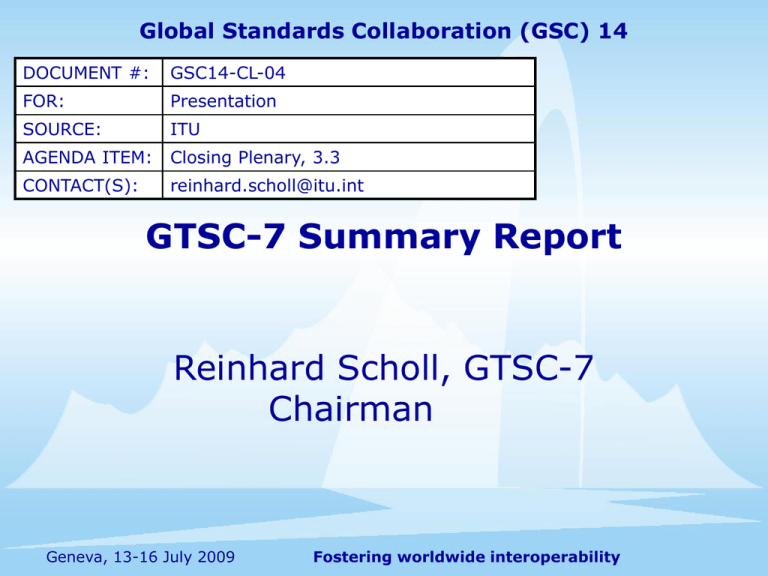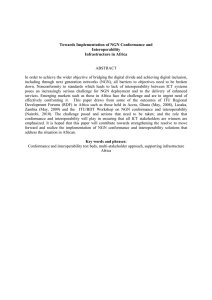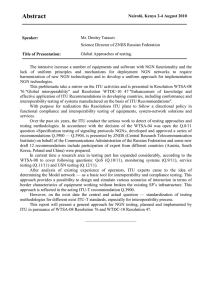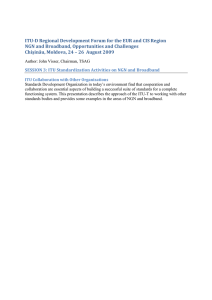Global Standards Collaboration (GSC) 14
advertisement

Global Standards Collaboration (GSC) 14 DOCUMENT #: GSC14-CL-04 FOR: Presentation SOURCE: ITU AGENDA ITEM: Closing Plenary, 3.3 CONTACT(S): reinhard.scholl@itu.int GTSC-7 Summary Report Reinhard Scholl, GTSC-7 Chairman Geneva, 13-16 July 2009 Fostering worldwide interoperability Meeting Overview Up to some 70 attendees 25 input documents Three High Interest Subjects, with revisions of respective Resolutions NGN – General (ETSI) (GSC-14/10) Cybersecurity (ATIS) (GSC-14/11) Home Networking (ITU) (GSC-14/12) New proposed Draft-Resolution “Interoperability” (GSC-CL-33) Geneva, 13-16 July 2009 Fostering worldwide interoperability 2 Presentations NGN (ETSI) Contributions GSC14-GTSC7-05, -09, -15, -21, -25R1, -16 Summary Foster co-operation. Interoperability continues to be important to NGN. Demand of adequate Quality of Service and security reconfirmed. The evolution of the NGN is driven by innovations in user applications and network capabilities. Global operation of NGN services including converged services. Guidance is needed on mechanisms to enhance interoperability without compromising innovation and timely standards development and deployment. Rich content and features be delivered to end users so that they can benefit from them in their daily life. Facilitate interoperability, innovation, market competition and infrastructure development to address user needs in a timely and cost effective basis. Converged policy management across a range of access technologies, in the context of Common IMS. Resolution After extensive discussion, consensus emerged to: Charge a drafting group with merging the Resolution Next Generation Networks (NGN) and the draft Resolution “NGN Interoperability” (GSC-PLEN-062 by TTC). The revised Resolution “NGN” (GCS-PLEN-17) was submitted by the drafting group to the GSC-14 closing plenary for approval. Charge a separate drafting group to see if it could reach consensus on a potentially new Resolution on “Interoperability” (with a broader scope than just NGN Interoperability) – the new draft Resolution “Interoperability” was submitted to GSC-14 closing plenary for approval. ask the HoDs to consider broadening of the scope of the High Interest Subject “NGN Interoperability” to “Interoperability”, with TTC as the Prime-PSO Geneva, 13-16 July 2009 Fostering worldwide interoperability 3 Cybersecurity (ATIS) Presentations Contributions GSC14-PLEN-045 and GSC14-GTSC5- 03, 06, -11, -12, 19, -26 (-6a1, -17 for information) Summary It was noted that Cybersecurity continues to be one of the top priorities in the GSC members. New forms of attacks have emerged, including the distribution of malware via the web Countries/regions are developing best practices to address the cybersecurity challenges. Information about these experiences and best practices could be helpful to developing countries, e.g. the development of self-assessment tools. Effective cooperation and collaboration across the many organizations, including standards bodies, doing Cybersecurity work is essential. Sharing sensitive cybersecurity information among entities requires the development of trust. Trust grows on a person-by-person basis between organizations, and can not be imposed. Multiple global frameworks exist due to multiple trust groups, multiple functional networks of organizations Resolution A drafting group was charged with revising the Resolution regarding Cybersecurity starting with the baseline text contained in GSC13-CL18. Following review, the text in GSC14-CL-18 was drafted as the Resolution to be submitted to the closing plenary for GSC approval as Resolution GSC-14/11. Geneva, 13-16 July 2009 Fostering worldwide interoperability 4 Home Networking (ITU) Presentations Contributions GSC14-GTSC7-07R1, -08R1(TIA), -10(ATIS), -14(CCSA), -18R1(ETSI), 22(ITU), -24(TTA), -27(TTC) including information sharing by GSC14-PLEN-78R1, 80(IEEE), -82(Broadband Forum) and -84(HGI). Summary A Home Network must consider many different devices and various means of transport, while at the same time provide reliability, predictability, security and acceptable performance. With current standards activities there is no assurance of successfully integrated specifications enabling a home network which can be deployed with reasonable effort, and be easily maintained. There is a significant amount of technical work required for device and service discovery within the home network to address issues related to the connection and discovery of devices and services that is necessary to enable a satisfying user experience. Femto cells may be deployed in various applications to support increased coverage and Home Network enhanced services. In addition to the converged service between telecommunication and broadcasting, the other industries such as electric power, water, gas services would be also converged with Telecommunication service in Home Area. Smart Grid could be the first target for the collaboration of Inter-Industrial Standardization. The Home Network is the crux of energy usage for most consumer premises. The management of the network, devices, integration with home automation aspects such as utilities, and the ability to monitor energy usage remotely is a key driver for the use of ICT to combat rising CO2 emissions. There must be an increased effort to encourage Home Networking standardization bodies to work together to bring about global solutions. The JCA-HN continues to encourage cooperation with other Home Networking bodies. Resolution The existing Resolution regarding Home Networking was revised based on the contributions and the revised resolution is provided in GSC-CL-19 and submitted to the GSC-14 closing plenary for approval. Geneva, 13-16 July 2009 Fostering worldwide interoperability 5


